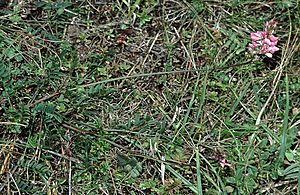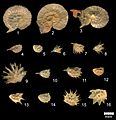Sainfoins facts for kids
Quick facts for kids Sainfoins |
|
|---|---|
 |
|
| Flowering Onobrychis arenaria | |
| Scientific classification |
|
| Kingdom: | Plantae |
| Clade: | Tracheophytes |
| Clade: | Angiosperms |
| Clade: | Eudicots |
| Clade: | Rosids |
| Order: | Fabales |
| Family: | Fabaceae |
| Tribe: | Hedysareae |
| Genus: | Onobrychis Mill. |
| Species | |
|
Some 140-150, see text. |
|
| Synonyms | |
|
Dendrobrychis (DC.) Galushko |
|
Onobrychis, also known as sainfoins, are a group of plants found in Europe and Asia. They are perennial plants, meaning they live for more than two years. Sainfoins belong to the Fabaceae family, which is also called the legume or pea family.
There are about 150 different types, or species, of sainfoin plants. Many of these species are found in Central Asia and Iran. One type, O. viciifolia, grows naturally in many parts of Europe and North America. It especially likes grasslands with chalky soil.
What are Sainfoins Like and How are They Used?
Sainfoins are mostly warm-weather plants. But you can find them across Europe, even as far north as southern Sweden. These plants often grow in grasslands, on agricultural land, and in wild, unused areas.
Their leaves are made up of many small leaflets, usually 6 to 14 pairs. Sainfoins have pretty pale pink flowers. They usually bloom from June to September. Bees, like honey bees and solitary bees, help them spread their pollen.
The plants produce round pods with one seed inside. Many species have spikes or bumps on their pods. These spikes help the pods stick to the fur of large animals. This is how the seeds get carried to new places to grow.
Why Sainfoins are Important
Sainfoins are very good for animals to eat. In the past, they were an important forage (food) for horses working on farms. Today, they are still a great source of nectar for making honey. Bees also get pollen from them for their food.
Sainfoins contain special substances called tannins. These tannins help animals digest proteins better. This means animals get more goodness from the food they eat. Sainfoin plants have deep taproots. This helps them find water deep underground, making them very good at surviving droughts. However, they don't grow back well if animals eat too much of them (this is called overgrazing).
Because they grow slowly in dry areas, sainfoins are not easy to plant as regular pasture. They also don't last long in grasslands. They only produce one harvest of hay or seeds each year. Because of this, they are not grown as much as other crops. But O. viciifolia is a bit more common.
Some caterpillars also eat Onobrychis plants. For example, the case-bearer moth Coleophora colutella eats O. saxatilis. The Damon Blue butterfly also feeds on sainfoin.
Nutritional Benefits and New Discoveries
Sainfoin is excellent food for grazing animals. Cattle and sheep will eat about 20% more sainfoin than grass. Unlike many other plants in the pea family, sainfoin does not cause bloat in animals. Bloat is a serious condition where gas builds up in an animal's stomach.
Sainfoin also helps animals fight against worms. This is because of the condensed tannins it contains. These tannins protect animals from bloat and help them absorb more protein. Animals that eat sainfoin gain weight quickly. This means young animals can be ready for market sooner. They also have very good meat quality.
Because of these benefits, sainfoin is very useful for farmers who use natural methods. It is also good for organic farmers. Sainfoin can produce a lot of food, around 16 tons of dry matter per hectare.
Latest Research on Sainfoin
Scientists have been studying the special compounds in sainfoin. These compounds include tannins and flavonoids. They have found that different types of sainfoin have different amounts of these compounds. This research helps in developing new and better sainfoin plants.
One important goal is to help ruminant animals (like cows and sheep) use nitrogen better. This can also help reduce greenhouse gases, like methane. Sainfoin is good for this because it contains condensed tannins. Even though sainfoin has less nitrogen than some other plants like lucerne, its food value is still high.
Future research will look at how the structure of condensed tannins affects animals. Scientists will test their findings on growing sheep and cattle. They will also study lactating ewes, goats, and cows. These studies will use diets that include different types of food and supplements.
Sainfoin is rarely grown by itself. It is usually mixed with other plants in pastures. Common mixes include cocksfoot (Dactylis), ryegrass (Lolium), or other legumes like red clover or white clover. Choosing the right type of sainfoin is important. For example, a type called Esparcette has a lot of condensed tannins. This means even a small amount in a mix can be very helpful.
Making silage from legumes is a good way to store food for animals on the farm. Silage is preserved plant material. It is better than making traditional hay because it depends less on good weather. Silage also keeps the food quality high during harvest. Wrapped silage bales of sainfoin are especially promising for animal nutrition. Farmers can use them, as research shows that the benefits of condensed tannins are not lost when sainfoin is made into silage.
Where Did the Name Come From?
The name Onobrychis comes from Ancient Greek words. Onos means "donkey" and brykein means "to eat greedily." So, Onobrychis means "devoured by donkeys." This name shows how good sainfoin is as food for large plant-eating animals.
The English name Sainfoin comes from Old French. Sain foin means "healthy hay." In the 1500s, a soil scientist named Olivier de Serres wrote about it. He said the plant was called sain-foin in France because it was so good for medicine and for making livestock fat.
In northern European languages, the name often comes from esparceto. This was a word from the Provençal language for similar plants. For example, in Danish it's esparsette, and in German it's Esparsette.
The Cock's Head (O. caput-galli) plant has a very old name. The ancient Dacian language called it aniarsexe or aniassexie. This is one of the few words we know from that language.
In the book Coming Up for Air by George Orwell, a character often remembers the smell of sainfoin. He remembers it from his father's seed shop.
Images for kids
-
Seedpods of various Onobrychis species:
1) O. hypargyrea, 2) O. pallasii, 3) O. radiata
4) O. petraea, 5) O. supina, 6) O. gracilis, 7) O. stenorhiza, 8) O. alba ssp. calcarea
9) Onobrychis humilis ssp. humilis 10) O. conferta ssp. hispanica, 11) O. montana, 12) O. arenaria ssp. tommasinii
13) O. oxyodonta, 14) O. inermis, 15) Cock's Head (O. caput-galli), 16) O. aequidentata
See also
 In Spanish: Onobrychis para niños
In Spanish: Onobrychis para niños





